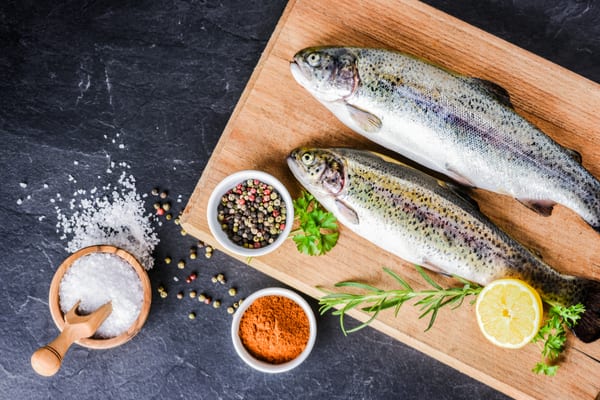Trout, the lowly fresh water fish sought after by fly fishermen over the centuries, has had a resurgence in the foodie world, thanks to it’s newly discovered “superfood” properties. A 3oz. cooked trout has just 162 calories, a whopping 22.64 grams of Protein, just 7.2 grams of Fat (and it’s that good Omega-3 fat, too), Zero Carbs (all you Ketos are salivating now), 47 mg of Calcium, 24 mg of Magnesium, 394 mg of Potassium, 13 μg of Folate (Mommies-To-Be, are you paying attention?) and 54 IU of Vitamin A.
Here are some more trout truths:
- Trout are a member of the Salmonidae family and are closely related to salmon and char.
- Trout is the common name for various species, including rainbow trout, brown trout, and brook trout. Rainbow trout is commonly found in grocery stores.
- Trout are an excellent source of protein, niacin, vitamin B12, and omega 3 fatty acids
.
- Protein is the building blocks of our body. It is important in growth and development and assists in repairing damaged tissues.
- Niacin is important in converting the food we eat into energy as well as assisting with digestive, skin, and nerve functions within the body.
- Vitamin B12 is required to form red blood cells which deliver oxygen throughout the body. B12 is also essential in supporting brain health and in creating DNA which holds our genetic material.
- Omega-3 fatty acids are necessary for brain function by aiding in memory, performance, and behavior as well as assisting with normal growth and development. Research has also shown that omega 3 fatty acids reduce inflammation and may help lower your risk of chronic disease such as heart disease, cancer, and arthritis.
- Omega-3’s also help promote heart health by supporting healthy blood pressure and triglyceride levels.
- Many people have concerns about mercury and fish. Trout is an excellent option when eating fish due to its high omega-3 fatty acid content and its low levels of mercury. If eating locally caught trout, contact your DNR to find specific eating recommendations. If you want to know more about how to find sustainable and healthy fish to consume, check out seafoodwatch.org.
- When purchasing fresh trout at your local market, it should be refrigerated or displayed on a thick bed of ice. It should smell fresh and mild, avoid if it smells too fishy, sour, or ammonia-like. The flesh should be shiny, firm and free from slime. Fillets should have no discoloration, darkening or drying around the edges.
- If purchasing frozen trout, avoid packages that have been tampered with or those with ice crystals. Ice crystals signify a food has been thawed and refrozen.
- Soon after purchasing, store trout in the refrigerator if using within two days or in the freezer if not using right away. When thawing trout, place in the refrigerator overnight. If the trout needs to be thawed sooner, seal in a plastic bag and immerse in cold water.
- Seafood should be cooked to a temperature of 145°F. Insert a food thermometer to check the temperature. If you do not have a thermometer, fish should be flaky and separate easily with a fork.
- Trout is really versatile, and tastes great prepared in a variety of ways, like pan-fried, oven baked, smoked or poached. You can even wrap it in foil and put it on the BBQ. Or heck, make it into a mousse and serve it on toasted baguette! Yum, marthastewart.com has a host of great trout recipes for you to try at home.
Now that you’ve got the real fish facts, trot on out to the store, get yourself some trout and start cooking! Just be careful of the bones!
—
Photo Credit: Krasula / Shutterstock.com
